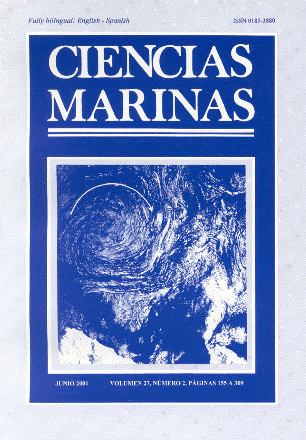Short-term temporal variability of Ag, Cd and Cu in Mytilus californianus and the effectiveness of this organism as a bioindicator
Main Article Content
Abstract
In order to study the short-term temporal variability of the concentration of Ag, Cd and Cu in Mytilus californianus and to determine the effectiveness of this organism as a bioindicator of these metals, 11 simultaneous samplings (every other day) were conducted from 24 August to 23 September 1995 at one polluted site and one unpolluted site at Todos Santos Bay in Ensenada, Baja California, Mexico. The concentrations of Ag and Cu (µg g–1 dry weight) were significantly greater at the polluted station (0.64–1.69 and 6.72–9.10, respectively) than at the unpolluted station (0.05–0.27 and 5.48–7.00, respectively), possibly due to the proximity of the polluted station to a wastewater discharge. The concentrations of Cd at the unpolluted station (1.37–5.25) were significantly greater than those at the polluted station (0.60–2.13), probably due to the association of Cd with upwelling, which is a common occurrence at the unpolluted station during the time the samplings were conducted. The relationships between the raw concentrations of the metals studied and the concentration normalized by the condition index indicate that M. californianus is a better indicator of Ag and Cd than of Cu.
Downloads
Article Details
This is an open access article distributed under a Creative Commons Attribution 4.0 License, which allows you to share and adapt the work, as long as you give appropriate credit to the original author(s) and the source, provide a link to the Creative Commons license, and indicate if changes were made. Figures, tables and other elements in the article are included in the article’s CC BY 4.0 license, unless otherwise indicated. The journal title is protected by copyrights and not subject to this license. Full license deed can be viewed here.

